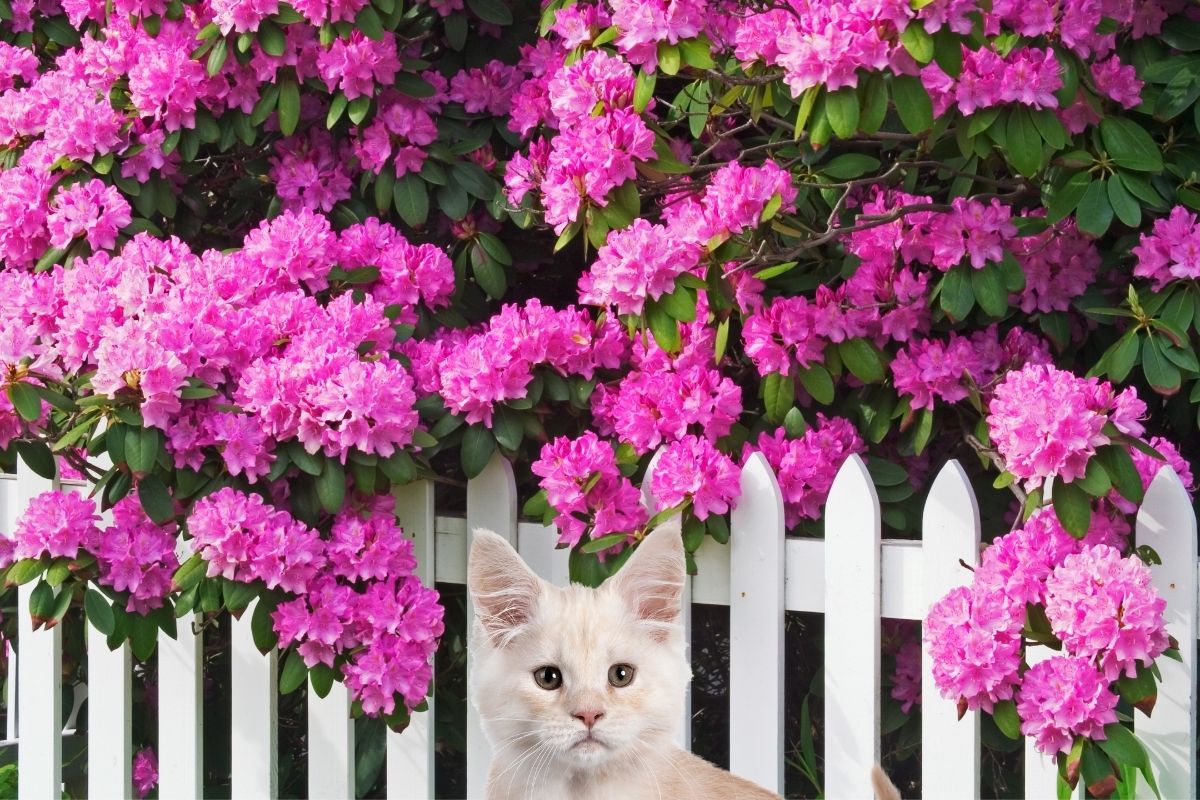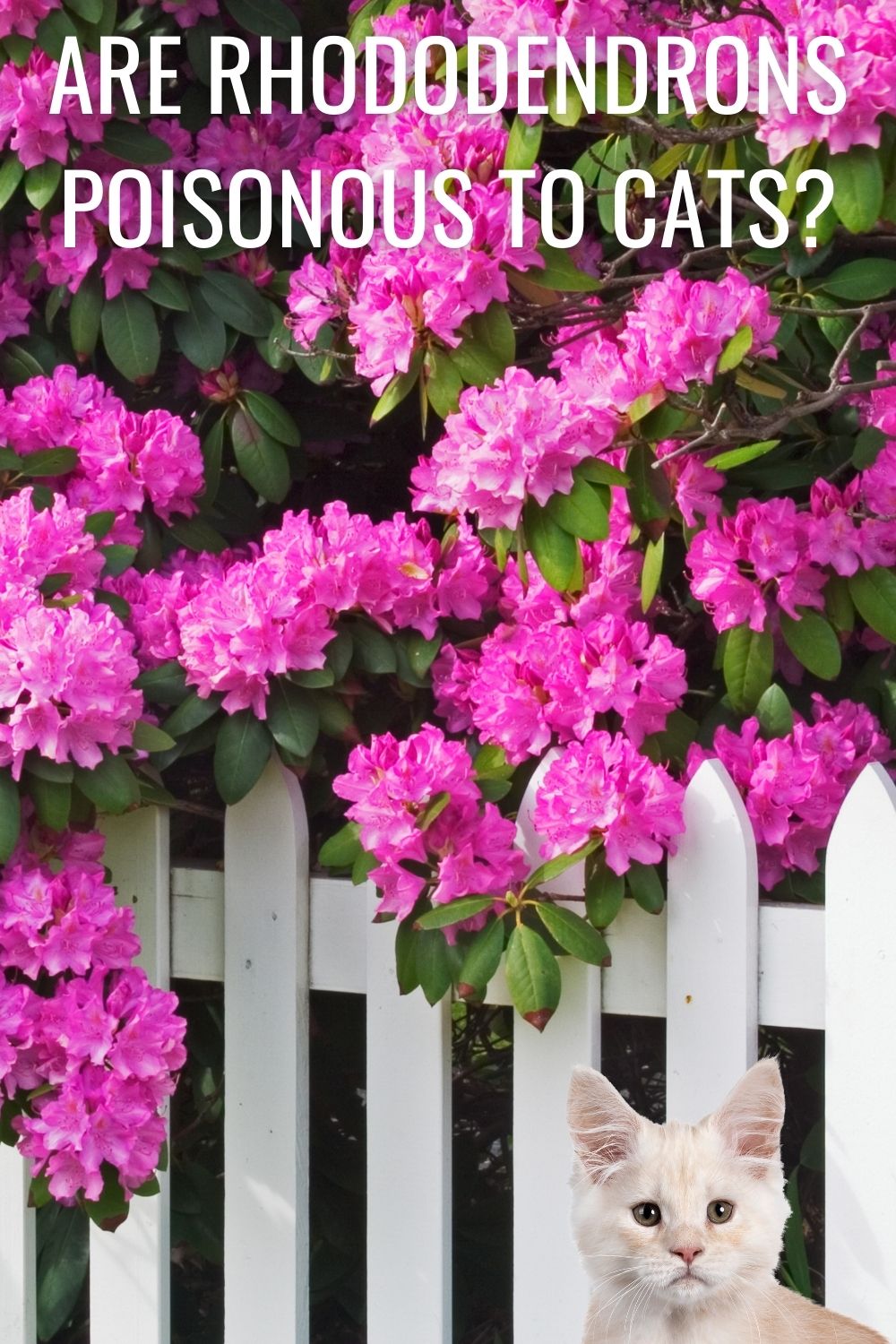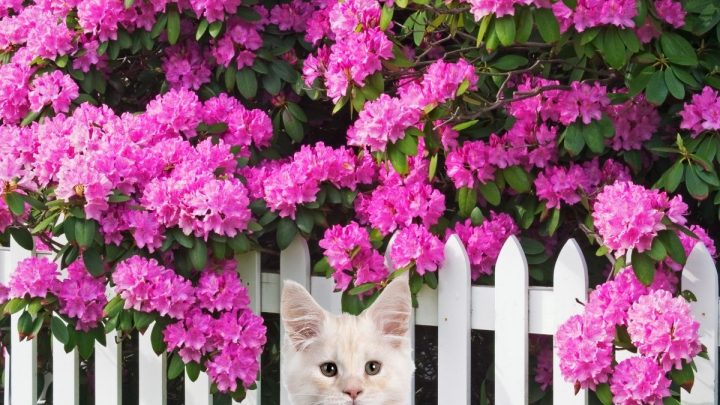Rhododendrons are a popular plant that you will find in landscapes all over. But if you have felines, you may be wondering, “Are rhododendrons poisonous to cats?” It’s a great question to ask because as humans, we have a responsibility to keep our kitty friends safe at all times.
Yes, rhododendrons are poisonous to cats. In fact, all parts of this plant are toxic and have the potential to make your cat seriously ill. Due to their small size, cats are in danger when ingesting this plant. Rhododendrons have a toxic chemical called “grayanotoxins” that make them so dangerous to your kitty friends.

It’s important to keep your kitties away from this poisonous plant. Now, let’s take a look into this more and also at how you can keep your cats safe from this and other toxic plants.
If you have cats and flowers in your home, this book may come in handy: Don’t Feed Me to Your Cat! A Guide to Poisonous Houseplants
What is Rhododendron Poisoning?
The rhododendron is a shrub that can grow up to five feet tall. It has shiny, green leaves with a dark underside and colorful blooms in various colors like white or yellow petals surrounding orange stamen (the male part). These common plants typically only produce one flower per branch but it’s enough for its beauty which often attracts butterflies!
You’ll find this hardy species across North America from Canada down to Mexico where they’re commonly cultivated by homeowners on hillsides overlooking cities. However, it’s important to realize it can be dangerous to small animals like cats.
The rhododendron is a toxic plant with the potential of causing serious damage to cats because of its small body size. The presence of ‘grayanotoxins’, composed of water-soluble diterpenoid compounds that bind themselves inside channels on cell membranes in your cat leading them towards depolarization – which can cause issues throughout their bodies and inhibit normal organ function or even lead directly to death if not treated quickly!
Learn more about plants that are poisonous to cats.
Symptoms of Rhododendron Poisoning in Cats
If you suspect someone has eaten rhododendrons, immediately call 911 for medical help. Symptoms such as nausea and vomiting are likely signs that poisoning may have occurred so it’s important to get this checked out right away! All other symptoms on the list should be monitored by a doctor or nurse while waiting for emergency services to arrive at your home.
A few examples would include:
- Nausea
- Vomiting
- Diarrhea
- Excessive drooling
- Nasal discharge
- Lack of appetite
- Dysphagia (difficulty swallowing)
- Depression
- Weakness
- Abdominal pain
- Abnormal heart rate
- Dyspnea (difficulty breathing)
- Lack of coordination
- Limb paralysis
- Blindness
- Cardiac abnormalities
- Hypotension (low blood pressure)
- Coma
Causes of rhododendron poisoning in cats
The simplest answer to what causes rhododendron poisoning in cats is: they eat the plant. All parts of the plant are toxic and there are many different reasons why cats eat plants.
The leaves of most rhododendrons stay green throughout winter, which may lead to outdoor cats being more prone to sample them as there is no other foliage around. The stem and flowers are highly toxic and sampling just three leaves could be enough for your cat’s death.
Diagnosis of rhododendron toxicity in cats
The sooner you take your cat in after they’ve eaten something that might be harmful, the better. If it’s been a few days and their symptoms have started to show up – like vomiting or diarrhea- then there may not still be time for treatment before things go from bad to worse. As soon as you know your cat has ingested something (especially if you know that it was rhododendron), call the vet immediately.
When treatment is started within hours of ingestion, there is a better chance of a full recovery and no long-lasting side effects.
The veterinarian will conduct a physical examination of your cat. They may use the stethoscope and listen for breathing or heart rate problems, as well as note any abnormalities in those metrics if present.
Treatment of Rhododendron Poisoning in Cats
Treatment for rhododendron poisoning will depend on the symptoms and their severity. In some cases, hospitalization along with close monitoring of your cat may be required; emesis occurs when vets induce vomiting in order to remove any undigested plant material from their stomach.
Sometimes the vet will need to use activated charcoal to make your cat throw up the plant toxins. This may need to be done more than once and the vet will usually keep your cat on IV fluids to keep them hydrated throughout the process.
In severe cases, other supportive care may be needed to support vital organ functions, including respiratory support. There may also be certain medicines your vet prescribes to help your cat with its recovery.
Every cat is different and the exact reaction your cat has can be unpredictable. Your vet will know just what to do and also which clinical signs of poisoning to look out for.
Recovery of rhododendron poisoning in cats
In most cases, when treatment is obtained right away, your cats will recover completely. This is why it is so important to act fast and not wait. If your cat has not ingested much of the plant, it will probably be okay, but it’s better to be safe than sorry. So, always get checked out by a vet right away.
Are Rhododendrons Poisonous to Cats? Conclusion
As you can see, yes, rhododendrons are poisonous to cats. If you have an indoor-only cat, it’s easy enough to keep your cat safe. Just don’t bring any parts of this plant inside. However, if you have outdoor cats, or if there are neighborhood cats that roam around your property, you will need to take extra steps to keep them safe.
If there are rhododendrons in your garden, you might use natural deterrents to keep the kitties safe. For example, vinegar or cayenne pepper around the garden bed will often make the cats stay away because they don’t’ like the smell. The only way to be 100% certain your cat is safe is to remove the rhododendron or keep your cat indoors.



